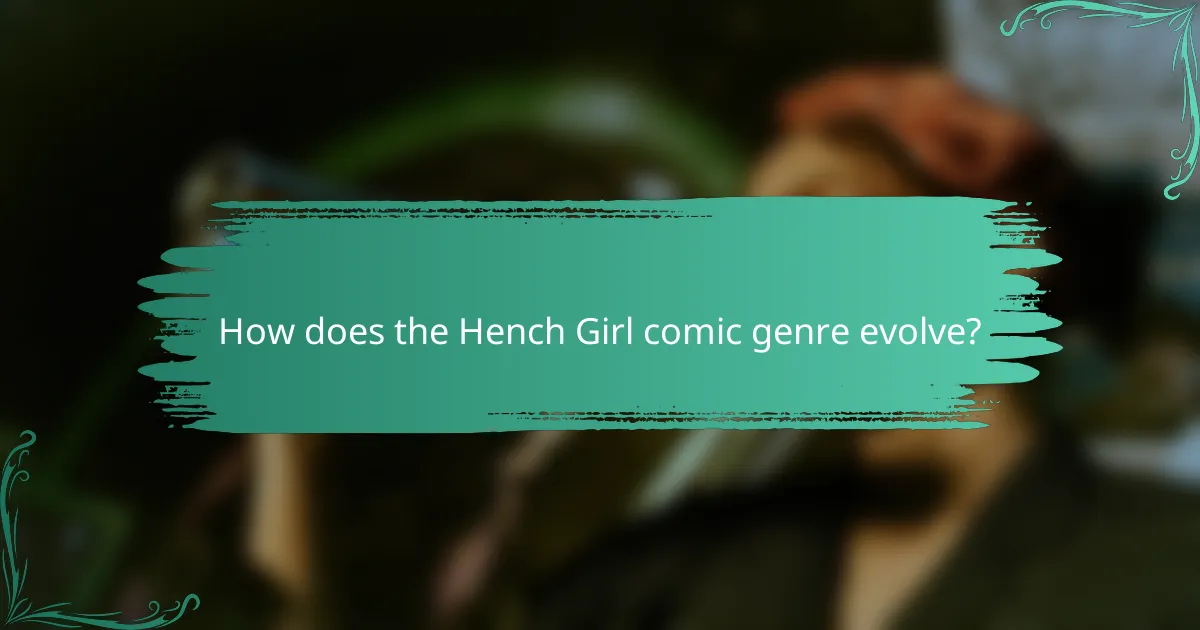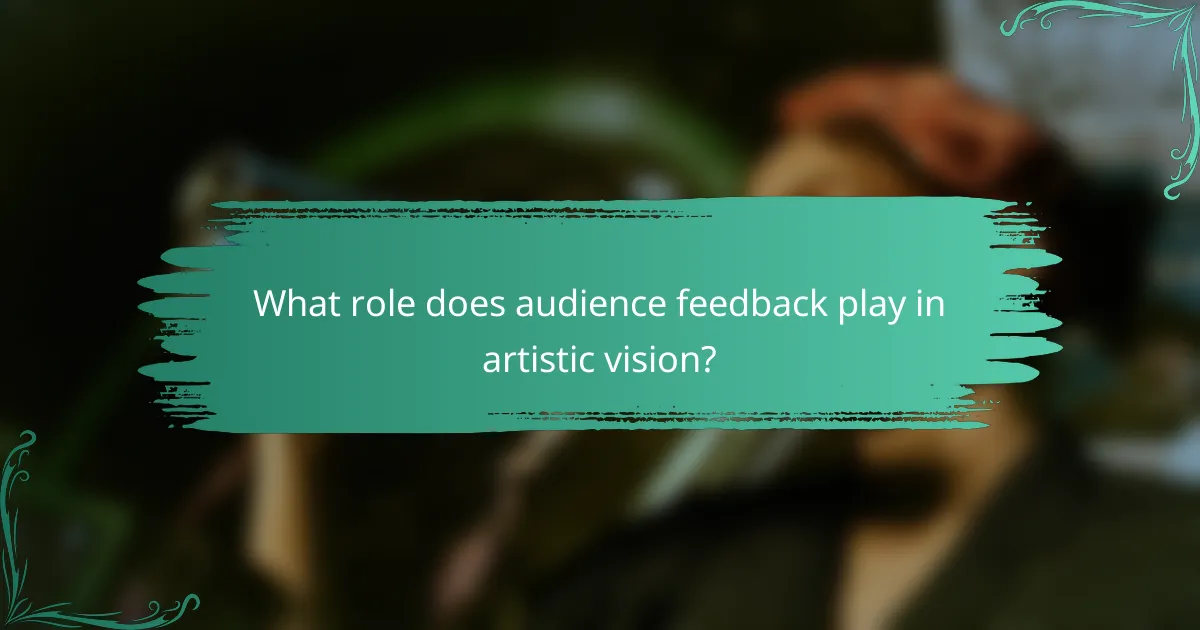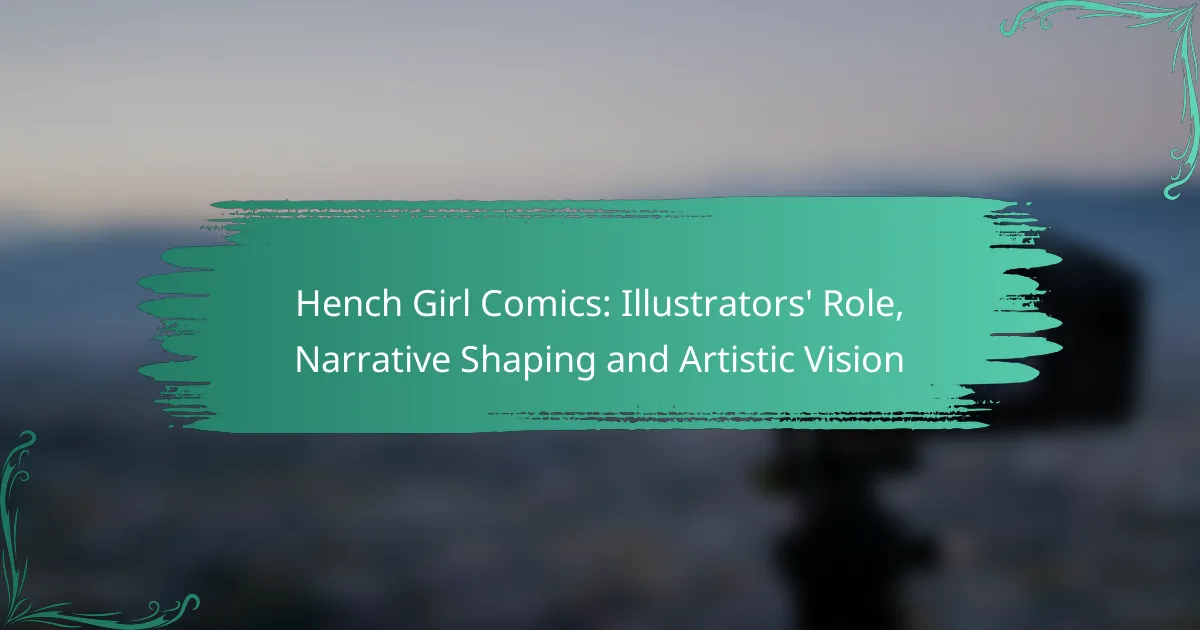In Hench Girl comics, illustrators play a pivotal role in shaping narratives by visually conveying character emotions, actions, and settings. Their artistic choices, including the use of color palettes and dynamic illustrations, significantly influence reader perception and engagement with the story. Notable artists like Jill Thompson and Claudia Aguirre have contributed to the genre’s depth and appeal, inspiring new creators with their unique styles.

How do illustrators shape narratives in Hench Girl comics?
Illustrators play a crucial role in shaping narratives in Hench Girl comics by visually conveying character emotions, actions, and settings. Their artistic choices directly influence how readers perceive the story and connect with the characters.
Character development through visual storytelling
Visual storytelling allows illustrators to enhance character development by using distinct styles and expressions. For instance, a character’s facial expressions can reveal their inner thoughts or conflicts, making them more relatable to the audience.
Additionally, the use of color palettes can signify a character’s emotional state or evolution throughout the story. A shift from bright to muted colors may indicate a character’s journey from optimism to despair, deepening the narrative impact.
Creating emotional depth with artistic style
The artistic style employed in Hench Girl comics significantly contributes to the emotional depth of the narrative. Stylized illustrations can evoke specific feelings, such as humor or tension, depending on the context of the scene.
For example, exaggerated features or whimsical designs can create a light-hearted atmosphere, while darker, more realistic art can amplify serious themes. This artistic choice helps readers engage with the emotional core of the story.
Influence of panel layout on pacing
Panel layout is a vital element in controlling the pacing of Hench Girl comics. A dynamic arrangement of panels can create a sense of urgency, while larger, more spaced-out panels allow for reflection and absorption of the story.
For instance, using a grid layout for action sequences can convey rapid movement, whereas a single, expansive panel may emphasize a pivotal moment. Understanding how to manipulate panel layouts effectively can enhance the overall reading experience and narrative flow.

What artistic techniques are used in Hench Girl comics?
Hench Girl comics utilize a variety of artistic techniques to enhance storytelling and character development. Key methods include the strategic use of color palettes, dynamic action illustrations, and rich symbolism that together shape the narrative and engage readers.
Use of color palettes to convey mood
Color palettes play a crucial role in setting the emotional tone of Hench Girl comics. Bright, vibrant colors often signify action and excitement, while muted tones can evoke feelings of tension or melancholy. For instance, a scene depicting a chaotic battle might use bold reds and yellows, whereas a moment of reflection could be illustrated with softer blues and greens.
Artists often choose color schemes that align with character traits or story arcs. A character undergoing a transformation might shift from dark to lighter hues, visually representing their growth. This technique not only enhances the visual appeal but also deepens the reader’s connection to the narrative.
Dynamic action sequences through illustration
Illustrators in Hench Girl comics excel at creating dynamic action sequences that capture movement and energy. Techniques such as exaggerated poses, motion lines, and varying panel sizes help convey speed and intensity. For example, a character leaping into action might be depicted with a series of panels that progressively show their motion, creating a sense of fluidity.
Additionally, the arrangement of panels can influence pacing. Quick, successive panels can heighten excitement during a fight scene, while wider panels can slow down the action to emphasize a critical moment. This thoughtful layout keeps readers engaged and invested in the unfolding drama.
Symbolism and visual metaphors
Symbolism and visual metaphors are integral to the storytelling in Hench Girl comics. Artists often incorporate recurring motifs that represent broader themes, such as betrayal or loyalty. For instance, a shattered mirror might symbolize a character’s fractured identity or internal conflict.
Visual metaphors can also enhance character development. A character surrounded by shadows may indicate their struggle with moral ambiguity, while bright light could signify hope or redemption. These artistic choices enrich the narrative, inviting readers to explore deeper meanings within the story.

Who are notable illustrators in the Hench Girl comic genre?
Notable illustrators in the Hench Girl comic genre include Jill Thompson and Claudia Aguirre, who have significantly shaped the visual storytelling and thematic depth of these narratives. Their unique artistic styles and contributions have helped define the genre and inspire new creators.
Jill Thompson’s contributions
Jill Thompson is renowned for her whimsical and expressive art style, which brings a distinct charm to the Hench Girl comics. Her work often combines vibrant colors with intricate details, creating immersive worlds that resonate with readers.
Thompson’s storytelling approach emphasizes character development, allowing her illustrations to enhance the narrative. This synergy between art and story is crucial in engaging the audience and conveying deeper themes.
Claudia Aguirre’s artistic vision
Claudia Aguirre’s artistic vision in the Hench Girl genre is marked by her bold use of color and dynamic compositions. Her illustrations often reflect contemporary themes, making them relatable to a modern audience.
Aguirre’s ability to blend humor with serious undertones adds layers to her characters, enriching the overall narrative. This balance is essential for creating engaging stories that resonate emotionally with readers.
Other influential female illustrators
In addition to Thompson and Aguirre, several other female illustrators have made significant contributions to the Hench Girl comic genre. Artists like Faith Erin Hicks and Noelle Stevenson have brought their unique styles and perspectives, further diversifying the visual landscape of these comics.
These illustrators often explore themes of empowerment and identity, using their art to challenge stereotypes and inspire new narratives. Their collective efforts continue to shape the genre and encourage a new generation of creators.

What are the challenges faced by illustrators in this genre?
Illustrators in the hench girl comics genre face several challenges, including the need to balance commercial success with their artistic vision. They must navigate market demands while ensuring their work remains authentic and true to the genre’s themes.
Balancing commercial appeal with artistic integrity
Illustrators often find themselves at a crossroads between creating art that sells and maintaining their unique style. This balance is crucial, as commercial success can lead to greater opportunities, but sacrificing artistic integrity may alienate dedicated fans. A practical approach is to identify key elements that resonate with audiences while infusing personal creativity into the work.
For instance, incorporating popular tropes or character designs can attract a wider readership, but artists should strive to add their distinctive flair to these elements. Regularly seeking feedback from peers and fans can help gauge what resonates without compromising one’s artistic vision.
Addressing representation and diversity
Representation and diversity are critical considerations for illustrators in hench girl comics. Many readers seek stories that reflect a variety of backgrounds and experiences, making it essential for artists to portray characters authentically. This involves researching cultural contexts and avoiding stereotypes, which can enhance the narrative’s depth and relatability.
Illustrators can benefit from collaborating with writers and consultants from diverse backgrounds to ensure accurate representation. Additionally, creating a diverse cast of characters not only enriches the story but also appeals to a broader audience, fostering inclusivity within the genre.

How does the Hench Girl comic genre evolve?
The Hench Girl comic genre has evolved significantly, reflecting changes in societal attitudes and the comic book industry. This genre now emphasizes complex narratives and character development, moving beyond traditional villainous tropes to explore themes of empowerment and identity.
Emerging trends in storytelling
Recent trends in Hench Girl storytelling focus on nuanced character arcs and moral ambiguity. Writers are increasingly crafting stories that delve into the psychological motivations of hench characters, allowing for deeper engagement with readers. This shift often includes themes of loyalty, betrayal, and the quest for personal redemption.
Additionally, the incorporation of humor and satire has become prevalent, providing a fresh perspective on the superhero-villain dynamic. For instance, stories may highlight the mundane aspects of being a henchman, creating a relatable and entertaining narrative.
Impact of digital platforms on distribution
Digital platforms have transformed the distribution landscape for Hench Girl comics, enabling creators to reach wider audiences without traditional publishing barriers. Webcomics and digital publishing allow for immediate access and often lower costs, making it easier for independent artists to share their work.
Moreover, social media plays a crucial role in promoting these comics, as creators can engage directly with fans and build communities around their work. Crowdfunding platforms also provide financial support, allowing for more diverse stories to be told in the Hench Girl genre.

What role does audience feedback play in artistic vision?
Audience feedback is crucial in shaping the artistic vision of hench girl comics, as it provides illustrators and writers with insights into what resonates with readers. This interaction can guide narrative choices, character development, and overall style, ensuring that the content remains engaging and relevant.
Influence of fan communities on narrative direction
Fan communities significantly impact the narrative direction of hench girl comics by voicing their preferences and interpretations. Illustrators often monitor social media platforms, forums, and fan art to gauge audience reactions, which can lead to shifts in storylines or character arcs. For instance, if a particular character gains popularity, creators might expand their role in future issues.
Additionally, feedback can highlight themes that resonate strongly with audiences, prompting writers to explore these areas more deeply. This collaborative dynamic fosters a sense of investment among readers, making them feel like active participants in the storytelling process.
Adaptation of styles based on reader preferences
Illustrators often adapt their artistic styles based on reader preferences, which can vary widely across different demographics and regions. For example, some audiences may favor a more cartoonish aesthetic, while others might prefer a realistic approach. By analyzing feedback, artists can refine their techniques to align with what appeals to their target audience.
Moreover, trends in visual storytelling can influence artistic choices. If a specific style becomes popular within the genre, creators might incorporate elements of that style to attract and retain readers. This adaptability not only enhances the visual appeal of hench girl comics but also ensures that they remain competitive in a dynamic market.
